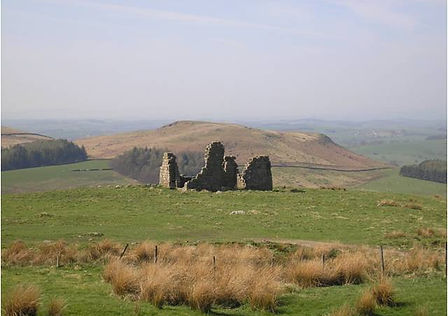



Rylstone Project
Lodge Farm Barn by Andrew Forman
Heading 6

Monuments and Buildings
This section describes the domestic, non-domestic and agricultural buildings, as well as the iconic monuments, to be found within Rylstone township.
It starts by providing a description of the buildings of historical importance situated in the central township area. Our intention here is not to display detailed drawings of individual buildings on our website, since this would intrude on owners' privacy, but to depict examples of vernacular household and farm design as they have changed over the centuries. It provides our own analysis of the development of the village from the 17th and 18th centuries, through the Victorian era, to the present day. Much of this work is based upon the project team's own surveys of the township and village properties. Rylstone householders have contributed significantly to this analysis and we are very grateful to all those who provided us with access to their properties and/or furnished us with information.
For completeness, we then present the detailed records from the English Heritage site of all the Listed Buildings within Rylstone. The second page provides a long listing of all the Historic Environmental Records (HER) for the parish, drawn up by the Yorkshire Dales National Park Authority. This extensive listing includes everything from listed buildings and major monuments, such as Norton Tower and St. Peter's Church, to historic trackways, quarries, old coal pits, cairns, bridges and sites with flints. It bears witness to the rich and varied history of Rylstone and the many points of interest to be found for those who wish to delve into the township's past.
Rylstone boasts several buildings and monuments which are of special note, and have been the subject of considerable external interest. As a result, they are are well documented and separate pages for each contain articles, photographs and analyses of their construction, key features and place they have had in the local community. These are:
-
St Peters Church, whose beginnings lie in medieval times, and which has been rebuilt several times. It is the parish church for Rylstone.
-
Rylstone Cross which has a strong presence in the local landscape, being sited at a high point on Rylstone Fell, and commemorates the peace treaty signed at the end of the Napoleonic Wars.
-
Norton Tower, an outpost of the Norton family, and thought to have been built by Richard Norton of Rylstone Hall in around 1540.
-
The post-medieval Toll House, which is situated by the current Skipton Road, below Scale House.
There are also the ruins of an interesting old building - Lane Head - which was formerly, The Waste Inn, and we provide a brief description and photographs of this.


